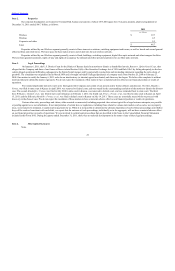Sprint - Nextel 2011 Annual Report Download - page 30
Download and view the complete annual report
Please find page 30 of the 2011 Sprint - Nextel annual report below. You can navigate through the pages in the report by either clicking on the pages listed below, or by using the keyword search tool below to find specific information within the annual report.
Table of Contents
250 free minutes of national, local, and long-distance monthly service.
We have focused our wholesale business to enable our diverse network of customers to successfully grow their business by providing them with an array of
network, product, and device solutions. This allows our customers to customize this full suite of value-added solutions to meet the growing demands of their business.
In addition to our brand and customer-oriented goals, we continue to focus on generating increased operating cash flow through competitive rate plans for
postpaid and prepaid subscribers, multi-branded strategies, and effectively managing our cost structure to align with reduced revenues from fewer postpaid subscribers.
Certain of our strategic decisions, such as Network Vision and the introduction of the iPhone®, which on average carries a higher equipment net subsidy, will result in a
reduction in cash flows from operations in the near term. However, we believe these actions will generate long-term benefits, including growth in valuable postpaid
subscribers, a reduction in variable cost of service per unit and long-term accretion to cash flows from operations. See “Liquidity and Capital Resources” for more
information.
Network Vision
In December 2010, we announced Network Vision, a multi-year network infrastructure initiative intended to provide subscribers with an enhanced network
experience by improving voice quality, coverage, and data speeds, while enhancing network flexibility, reducing operating costs, and improving environmental
sustainability through the utilization of multiple spectrum bands onto a single multi-mode base station. In addition to implementing these multi-mode base stations, this
plan encompasses next-generation push-to-talk technology with broadband capabilities and the integration of multi-mode chipsets into smartphones, tablets and other
broadband devices, including machine-to-machine products. Through the successful deployment of Network Vision, we expect to migrate to a single nationwide network
allowing for the consolidation and optimization of our 800 megahertz (MHz) and 1.9 gigahertz (GHz) spectrum, as well as other spectrum owned by third-parties, into
multi-mode stations allowing us to repurpose spectrum to enhance coverage, particularly around the in-building experience. The multi-mode technology also utilizes
software-based solutions with interchangeable hardware to provide greater network flexibility, which also allows for the deployment of LTE.
The first stages of equipment testing began in the first quarter of 2011, and we have achieved our initial technical milestones. Deployment has begun on
approximately 38,000 cell sites, and we powered on our first multi-mode base station on December 6, 2011. We expect to commercially launch this new technology in
certain markets by mid-year 2012. On October 2, 2011, we launched Sprint Direct Connect®, which is the next generation of push-to-talk technology. Further deployments
of Network Vision technology, including enhancements of Sprint Direct Connect®, are expected to continue through early 2014. We expect the plan to bring financial
benefit to the Company through migration to one common network, which is expected to reduce network maintenance and operating costs through capital efficiencies,
reduced energy costs, lower roaming expenses, backhaul savings, and the eventual reduction in total cell sites.
The successful deployment related to these changes in technology will result in incremental charges during the period of implementation including, but not
limited to, an increase in depreciation and amortization associated with existing assets, both Nextel and Sprint platform related, due to changes in our estimates of the
remaining useful lives of long-lived assets, and the expected timing of asset retirement obligations, which we expect will have a material impact on our results of
operations. We recorded a charge of $78 million related to network equipment, which has not been placed into service and that is no longer necessary for management's
strategic plans. In the first quarter of 2012, we formalized our plans to decommission roughly one-third of our total Nextel platform, or 9,600 towers, by the end of 2012.
We also expect to be completed with our transition of customers from the Nextel platform to our Sprint platform by the end of 2013, which should allow us to
decommission the remainder of our Nextel platform sites. As a result, in the first quarter 2012, we revised our estimates of the expected useful lives of certain Nextel
platform assets and asset retirement obligations through the end of 2013. Accordingly, approximately $2 billion of the remaining $3.6 billion net book value of Nextel
platform assets is expected to be accelerated through depreciation expense, of which a disproportionate amount is expected to be recognized during 2012. The exact
timing of the acceleration is dependent upon when the assets are expected to be phased out of service. These estimates are derived from our internal decommissioning
plan, which is still evolving. We estimate the incremental effect of accelerated depreciation related to Nextel platform assets in our 2012 results to be in the range of
approximately $1.2 billion to $1.5 billion.
28
























